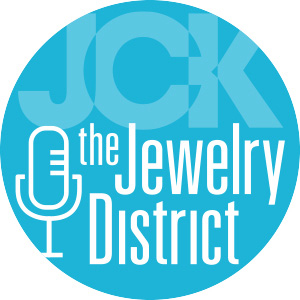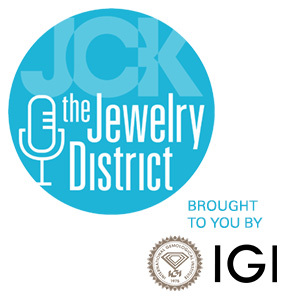
In This Episode
You’ll hear JCK editor-in-chief Victoria Gomelsky and news director Rob Bates talk with Eric Ku, watch “super dealer,” founder of 10 Past Ten, and cofounder of Loupe This and Los Angeles Watchworks.Eric recounts the origin story of when he first started his collection of mechanical watches, the beginnings of watch-collecting on the internet, the evolving relationship between brands and the pre-owned market, and he names a few micro-brands that have yet to get their due.
Listen Now
Show Notes
02:20 – The hosts introduce Eric Ku
04:20 – How Eric came to own his first watches
08:10 – The early days of the internet and online watch collecting
10:15 – Eric’s main business focuses
15:00 – Brands’ relationships with the secondhand market
20:45 – How Loupe This got started
25:00 – Some great lesser-known watch brands
27:30 – Eric’s first watch, “the one that got away”
Episode Credits
Hosts: Rob Bates and Victoria Gomelsky
Producer and engineer: Natalie Chomet
Plugs: loupethis.com, 10pastten.com, lawatchworks.com, @jckmagazine
Show Recap
Eric’s Watch Origin Story
Eric talks about where his love of watches came from. He subscribed to National Geographic and always noticed the Rolex ad on the back cover. In particular, he has been interested in mechanical watches and the history behind them. While in college at the University of California, Berkeley, Eric didn’t find a lot of others who shared his interest, however.
When Eric came into some money playing the stock market in college, it allowed him to buy some of his first nice watches. Soon after, he lost that same fortune the same way he had made it and had to sell them all. In a way, this quickly introduced him to both sides of the watch-selling business.
Eric’s first watch? An Omega Speedmaster Automatic with a clear display back. Back when he had purchased it, it cost him $999. At the time, he thought that this price was the benchmark for a “nice” watch. His first vintage watch was a Rolex Red Submariner. He got it in Columbus, Ohio, at an NAWCC (National Association of Watch and Clock Collectors) show. From the beginning, Eric had been drawn to Rolex because of the brand’s tie to feats of human ingenuity dating back to the 1930s.
The Watch Market Now and Then
During the early days of the internet and internet watch collecting, his friends used to fax pictures of watches to him! It was an active scene. He talked to other collectors online. He looked at other sites to learn about watches. The commercial part of it was at trade shows, not online yet. NAWCC would have a show in Pasadena, Calif., twice a year. He would attend these regional shows, walk around, meet people, and all the trading would happen there.
Eric’s Collection of Watch Businesses
What are Eric’s main business focuses? He started 10 Past Ten in the early 2000s, which is a website that sells vintage Rolex sport watches. This is one of the segments that is most heavily collected. It started as a part-time job. After a “moment of clarity,” he gave notice at his day job, rented an office, and never looked back.
Six years ago, Eric partnered with his friend Beau Goorey and started Los Angeles Watchworks, a repair and restoration business for fine Swiss watches based in Pasadena. They are known for their cosmetic work on watches, preserving the original look and feel while catering to the whims of watch collectors.
How does he handle counterfeits? With these fine vintage watches, it’s all in the details. There are specific tiny details that are not always original. With vintage watches, you won’t see a counterfeit that is perfect. It’s harder to replicate watches that are handmade.
Brands Embracing the Secondhand Market
Though they used to thumb their noses at it, brands are increasingly embracing the pre-owned market. Eric gives the example of Richemont, which bought Watchfinder (a secondhand watch business on the internet), and they slowly integrated it into their dealer network. They’ll look at trade-in watches and accept a customer’s trade-in as credit toward a new purchase. With new watches, there is a keystone. The margins are thinner for secondhand watches. Eric notes that the lack of availability of some new watches is an interesting factor. It benefits these brands to offer pre-owned watches, so that there is still some inventory.
Primary and Secondary Market Interplay
Victoria asks about the relationship between the primary and secondary markets. When there’s nothing available in the primary channel, people flood the secondary market with demand, and prices rise to extreme heights. Now that the prices for these hyped watches are going back down in the secondary market, what is Eric seeing in the primary? Does he see a link between the two? Eric has not seen interest in the primary market cooling just yet. Most authorized dealers would likely agree, they continue to have a waiting list for certain models of new watch. He notices that the retail prices of these watches are much lower than their market value.
What accounts for this growth of the watch market? Eric thinks it’s a mixed bag. The company-owned boutique model with fewer third-party partners has affected the supply. Back in the day, it was expected that you would go into a jewelry store and negotiate the price. Now, people don’t go to a brand boutique expecting a deal on a designer watch. On the consumer side, watch collecting used to be niche, but over time, the fashion world has embraced vintage things. That has moved the needle. Fashion magazines have watch writers. It’s different from even just 10 years ago.
The Birth of Loupe This
Eric talks about his online auction company Loupe This, which he started with Justin Gruenberg. Both co-owners are deeply involved in the watch auction market. Because they’re so familiar with it, they have their likes and dislikes about auctions. They didn’t like how high fees were. Other examples: how long it takes to list and the predictable seasons, which have gaps of time when there aren’t a lot of auctions. They created this platform that addressed many of their issues with in-person auctions. However, they don’t intend to replace traditional auctions. There’s an excitement about being in an auction room and watching everything happen. They do try to cater to a wider audience and have watches for sale every day.
His Personal Collection and Favorites
Victoria asks Eric to share his hit list of brands that haven’t gotten their due yet. It’s hard to predict! He thinks that the market is good at predicting what is undervalued/overvalued and adjusts. He names a few micro brands and relatively affordable brands that are still under the radar: Kurono, Ming, and Baltic.
How many watches does Eric have? Though he doesn’t know the exact number, he says his collection is fairly focused. (He has more than his wife would like, he says!) He likes watches with a story. He tells the story of his first watch that he sold and tried to buy back. Though he did get it back, he paid a world-record price. When he got it, his original documents were all still with it! He now plans to save it for his son.
- Subscribe to the JCK News Daily
- Subscribe to the JCK Special Report
- Follow JCK on Instagram: @jckmagazine
- Follow JCK on X: @jckmagazine
- Follow JCK on Facebook: @jckmagazine






